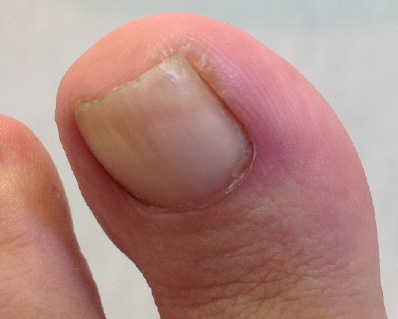What are ingrown toenails?
The medical name is onychocrytosis. The term ingrown suggests that the nail has actually grown into the skin. In actuality, a part of the nail protrudes into the nail sulcus skin or into the nail bed itself.
In milder cases, this can result in pain, discomfort or inflammation.
In more severe cases the nail pierces or breaks the skin allowing bacteria to enter and infections to develop. Ingrown toenails can cause significant impacts such as painful walking, discomfort wearing shoes and limitation of normal activities.

Ingrown toenails generally require professional treatment by a podiatrist to resolve the problem.
What are the causes?
Ingrown toenails affect people of all ages and can be caused by a number of factors including underlying health conditions that cause the feet to swell or be puffy. Excessive sweating or trauma to the nail is another common cause of ingrown toenails. Sports that involve the use of the foot and toes can further aggravate or exacerbate ingrown toenails. Poor nail hygiene or incorrect trimming also contribute to the development.
How are they treated?
Mild cases of ingrown toenails can be treated or managed by correct trimming and cutting of the nail. Some people manage really mild cases of ingrown toenails by having regular pedicures to keep the nails well-trimmed or regularly cut their own toenails. When these home management
strategies fail to work, it is time to seek treatment from a podiatrist.
Treatment
Your podiatrist will assess the nail to determine the best type of treatment. In mild cases, professional trimming of the nail might do the trick. Wearing well-fitted shoes can also help. In most cases that present to a podiatrist, a minor ingrown toenail surgery is required.
Surgery
Minor ingrown toenail surgery is known as a partial nail avulsion. The procedure is done under local anesthetic and involves removing a section of the nail plate and treating the nail chemically to prevent future regrowth. Recovery takes around 2-4 weeks with care taken to dress the site
regularly and monitor for infection.
More severe cases may require surgery to remove the whole nail. This procedure is known as a total nail avulsion.
Both procedures can be completed at a local foot clinic by a podiatrist. These procedures are generally covered through private health insurance, providing substantial rebates.
Prevention is the key to managing ingrown toenails.
To prevent the reoccurrence of ingrown toenails, your podiatrist will investigate the underlying cause of the problem and suggest some strategies to help you prevent the problem from occurring in the future.
Our team at Suncoast Podiatry is very experienced in surgical and non-surgical treatments, with a number of foot clinics located right across the Sunshine Coast including at Noosa, Bli Bli, Gympie and Cooroy
If your toenails have been giving you problems, book in for a consultation with one of our experienced podiatrists. Our podiatrists will assess your nails and give you some recommendations about the best treatment plan for you.
Visit our podiatrist contact page
For more information about ingrown toenails click here
